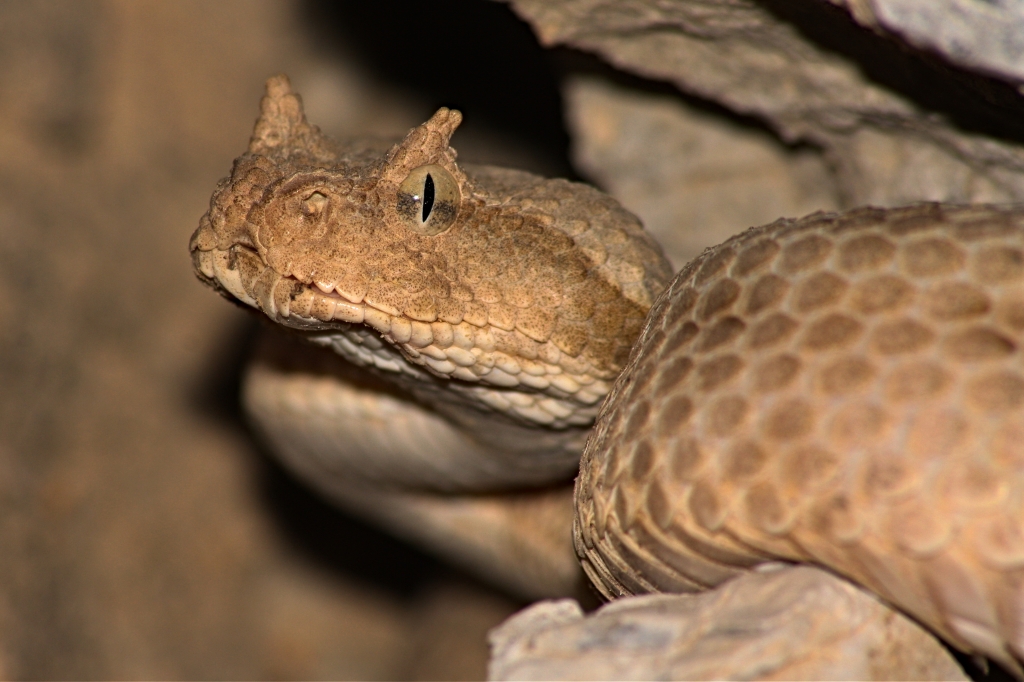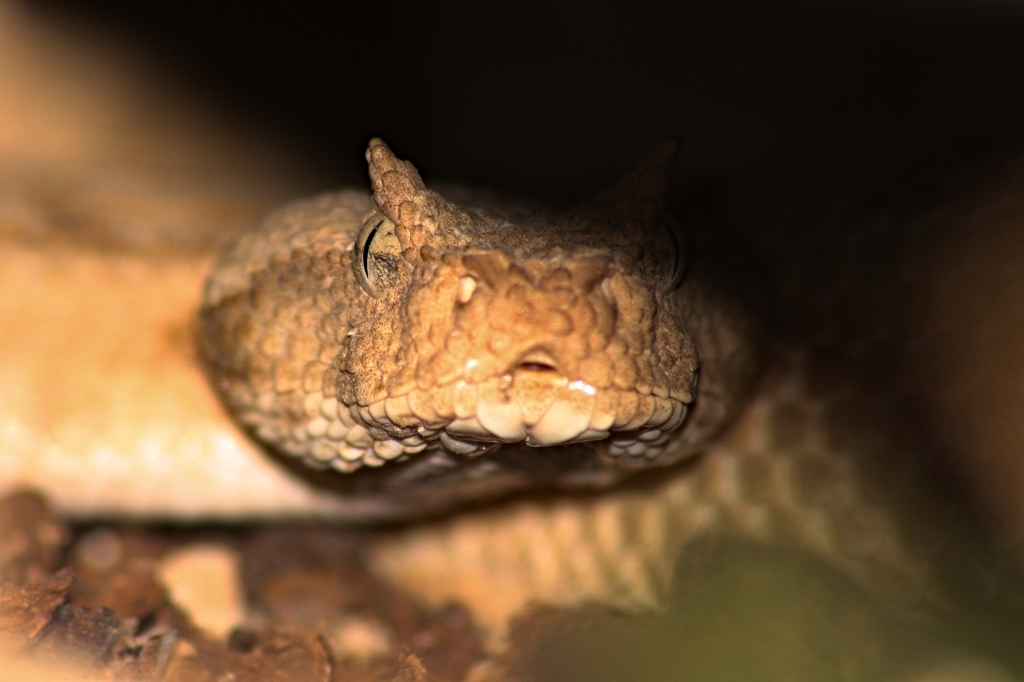The day I came across my first and only Persian horned viper was quite special, mainly since it nestled comfortably in the intersection of my Venn diagram of happiness; climbing, reptiles and science. I’d set out for the day to climb a crumbly multi-pitch VS, inappropriately named Fossil Face (I didn’t see a single fossil), with my friend André. On the approach to the crag I was, as always, scanning for reptiles and I froze as I stepped over a cluster of rocks when my brain realised what I’d just seen. It was the rarest snake in the UAE! After taking a minute to control myself, we took some photos and continued with the climb. I returned later that evening with Sean, another reptile-lover, and got some better photos with my camera.

The Persian horned viper (Pseudocerastes persicus) has the largest range of its genus, extending from Syria eastwards to Pakistan, but a small population resides in the Hajar mountains that span northern Oman and the UAE. It is listed globally as ‘Least Concern’ by the IUCN but is regionally ‘Vulnerable’ in Arabia. The species was thought to be restricted to upper elevations (>600m above sea level), as it can tolerate cooler temperatures and can escape competition with other vipers here. That was until some bumbling fool of a herpetologist stumbled across a specimen at 195 m a.s.l., published the finding, and then shamelessly self-cited in his blog (Thomas 2019)…

Persian horned vipers can use three out of the four types of snake movement (all but concertina) when navigating their environment, depending on the situation. Despite this range of locomotory abilities, they don’t actually move very much in the wild, meaning they have quite low dispersal resulting in slight differences between populations as they rarely meet and inter-breed. This has led to divergence in the venom composition of P. persicus which is important particularly for managing snake bite. Variation in venom composition can occur between species, within species and even ontogenetically (from juvenile to adult). As a result, treating snakebite becomes more difficult as antivenoms made from the venom of snakes in a different population to the one where the bite occurred may be less effective at treating the bite – meaning more antivenom vials, more cost and more risk to the patient.
Persian horned viper venom also has some real benefits. One study investigated the effects of P. persicus venom on cancer cells. Venom from this species has potent cytotoxic (cell-killing) abilities, so when the crude venom was applied to both healthy human cells and cancer cells, it wiped out all cells equally. However, once they had identified the specific components that were causing apoptosis (cell death) they isolated these and tested them separately.

Just 20 μl/ml (20 parts venom per million) of ‘Fragment 21’ of P. persicus venom caused significant death of cancer cells while leaving the normal human cells almost completely unharmed. Higher concentrations started to cause more damage to healthy cells while lower concentrations showed promising cancer killing properties. This work is brand new (published in September 2019!) so is very much in the early stages. I’ll be keeping my eyes peeled as snakes need all the help they can get with improving their image. Maybe the ability to kill cancer might make people think twice before taking this snake’s head off with a spade? Probably not but I can live in hope…

Quick facts:
- Ranges across large parts of the Middle East with a restricted population in the Hajar mountains.
- Able to use three out of four snake movement types.
- Component of its venom has been found to have cancer killing properties.
Further reading:
- Thomas, O. (2019). Persian horned viper (Pseudocerastes persicus): a record at unusually low elevation from the United Arab Emirates. Herpetological Bulletin, 147, 28-29.
- Yes I did it, I cited myself. Don’t tell me that you wouldn’t do the same thing though. Here I somehow managed to publish my first paper about probable elevational range expansion of a snake species. Lucky that nobody knows anything about reptiles really or this wouldn’t have happened.
- Shahbazi, B., Najafabadi, Z. S., Goudarzi, H., Sajadi, M., Tahoori, F., & Bagheri, M. (2019). Cytotoxic effects of Pseudocerastes persicus venom and its HPLC fractions on lung cancer cells. Journal of Venomous Animals and Toxins including Tropical Diseases, 25.
- The real focus of this tale. New work looking into how different concentrations of P. persicus venom components displayed promising anticancer properties by inducing apoptosis in lung cancer cells. Various toxins within the venom as a whole showed cytotoxic abilities, some more potent than others. This component of the venom is thought to create pores in the mitochondrial membrane leading to cellular stress and apoptosis.
- de Pous, P., Simó-Riudalbas, M., Els, J., Jayasinghe, S., Amat, F., & Carranza, S. (2016). Phylogeny and biogeography of Arabian populations of the Persian horned viper Pseudocerastes persicus (Duméril, Bibron & Duméril, 1854). Zoology in the Middle East, 62(3), 231-238.
- This paper gives a good background to the species as a whole but also the biogeography and relatedness of groups. They also find that the Arabian population is more related than previously thought to the Iranian snakes, suggesting that they diverged much more recently – perhaps even across the sea on floating debris.